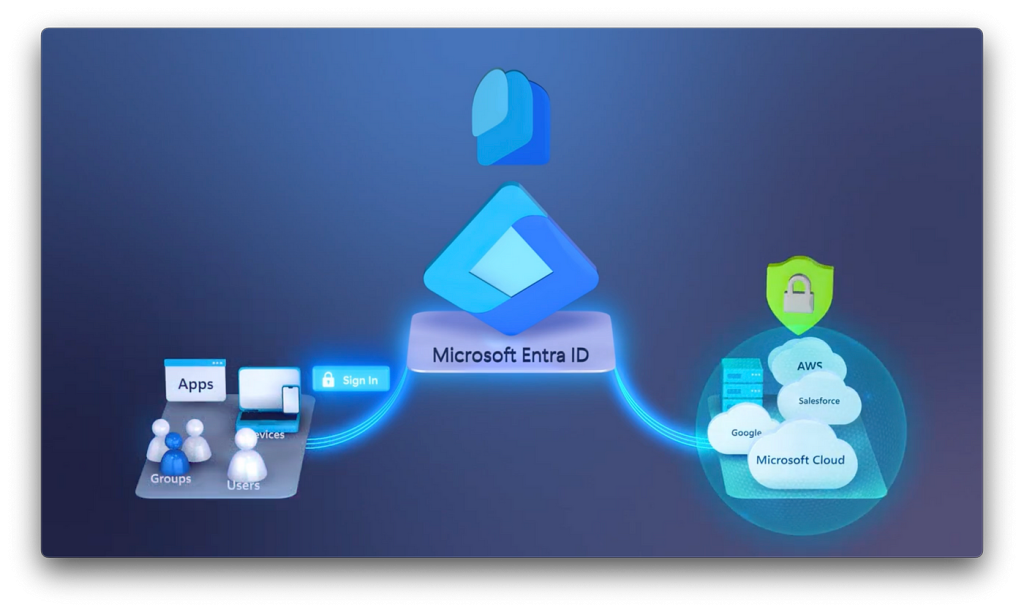In the ever-evolving digital landscape, identity management has become a crucial pillar of organizational security and operational efficiency. As businesses increasingly migrate to the cloud and adopt hybrid environments, the need for a robust, centralized identity solution has never been more apparent. Microsoft Entra ID, formerly known as Azure Active Directory (Azure AD), is Microsoft’s modern cloud-based identity and access management solution designed to help organizations securely manage user identities and control access to applications, data, and resources. This article explores how integrating Microsoft Entra ID with Microsoft 365 and other cloud services empowers businesses with seamless access control, enhances security posture, and streamlines IT administration.
The Rise of Identity-Centric Security
Modern enterprises are no longer confined within the perimeters of a traditional IT environment. With the widespread adoption of remote work, BYOD (bring your own device) policies, and SaaS-based applications, organizations face complex challenges in managing access across an expanding digital ecosystem. Here, identity becomes the new control plane. Rather than securing only the network perimeter, companies are now focusing on securing the identities that access corporate resources, regardless of location or device.
Microsoft Entra ID stands at the heart of this identity-centric security model. It offers a unified platform to manage employee, customer, and partner identities while providing secure access to applications inside and outside the organization. Its tight integration with Microsoft 365 and support for thousands of third-party cloud applications make it an indispensable tool for modern IT teams.
Seamless Integration with Microsoft 365
Microsoft 365 is one of the most widely used productivity suites in the world, offering tools like Outlook, Teams, SharePoint, OneDrive, and more. A significant advantage of using Microsoft Entra ID with Microsoft 365 is the native integration that allows users to benefit from a single sign-on (SSO) experience across all services.
When organizations deploy Microsoft Entra ID, it becomes the identity backbone for Microsoft 365. All user identities, permissions, and access policies are managed centrally in Entra ID. This centralized identity system ensures that users can access their emails, collaborate on documents, or join Teams meetings without repeatedly logging in across different platforms.
Additionally, IT administrators can use Entra ID to enforce multi-factor authentication (MFA), conditional access policies, and compliance controls across Microsoft 365 applications. For example, an organization might require employees to authenticate using a mobile app when accessing Outlook from outside the corporate network or block access entirely from risky countries or anonymous IP addresses.
The tight coupling between Entra ID and Microsoft 365 results in enhanced user productivity, improved security, and reduced IT overhead. Features like self-service password reset, user lifecycle automation, and detailed access logs provide additional value.
Extending Access Control Beyond Microsoft 365
While integration with Microsoft 365 is a major use case, Microsoft Entra ID is designed to manage access across a broad range of applications and services. Organizations often use multiple SaaS platforms—such as Salesforce, Dropbox, ServiceNow, Google Workspace, and Adobe Creative Cloud—to fulfill various business needs. Entra ID supports federated authentication and SAML-based single sign-on for thousands of these applications out of the box.
Through the Microsoft Entra Application Gallery, administrators can quickly configure SSO and user provisioning for over 3,000 third-party cloud applications. This means employees can use their existing Entra ID credentials to access both Microsoft and non-Microsoft services, eliminating the need to remember multiple usernames and passwords.
By managing all access through Entra ID, IT teams can enforce consistent security policies across applications, gain visibility into sign-in patterns, and detect anomalies that may indicate credential theft or misuse.
Additionally, Microsoft’s Conditional Access policies can be applied to all integrated apps, regardless of vendor. This level of control ensures that sensitive data remains protected, even when accessed through external cloud services.
Role-Based Access and Privileged Identity Management
Managing who has access to what—especially in large organizations—is a daunting task. Microsoft Entra ID simplifies this through role-based access control (RBAC) and Privileged Identity Management (PIM).
RBAC allows administrators to assign roles to users based on their job functions. For example, a marketing executive may be granted access to social media tools and campaign analytics, while a finance officer has access to accounting software and payroll systems. These roles can be predefined or customized based on the organization’s structure.
Privileged Identity Management, on the other hand, helps secure access to sensitive resources by allowing temporary elevation of privileges. Instead of granting permanent administrative rights—which pose a security risk—PIM lets users request elevated access for a limited time, subject to approval workflows and auditing. This principle of “just-in-time” access greatly reduces the attack surface for insider threats or compromised accounts.
When paired with audit logging and access reviews, Entra ID ensures that only the right people have the right level of access at the right time.
Enabling Zero Trust with Microsoft Entra ID
The Zero Trust security model assumes that threats can come from anywhere—inside or outside the network—and that no user or device should be trusted by default. Identity is foundational to Zero Trust, and Microsoft Entra ID plays a central role in enabling this model.
With Entra ID, organizations can implement a comprehensive Zero Trust architecture by:
- Authenticating and authorizing every access request using SSO, MFA, and conditional access.
- Continuously evaluating trust based on risk signals such as location, device compliance, user behavior, and sign-in patterns.
- Limiting access using least-privileged access principles via RBAC and PIM.
- Auditing access to ensure visibility and accountability.
Entra ID also integrates with Microsoft Defender for Identity, Microsoft Sentinel, and other security solutions to provide advanced threat detection, real-time alerts, and automated remediation.
Hybrid Identity and On-Premises Integration
Many enterprises are not entirely cloud-native and continue to rely on legacy systems and on-premises Active Directory (AD) environments. Microsoft Entra ID supports hybrid identity configurations, allowing organizations to extend their existing AD infrastructure to the cloud.
Through tools like Azure AD Connect (now part of Microsoft Entra Connect), organizations can synchronize on-premises user accounts with Entra ID, enabling consistent identity across environments. This hybrid model supports password hash synchronization, pass-through authentication, or federation with existing identity providers.
Such integration ensures that users have a seamless sign-in experience across on-premises and cloud resources. IT teams can also use Entra ID to modernize their authentication approach gradually, introducing cloud-only policies while still retaining compatibility with existing systems.
Managing External Identities and Collaboration
Modern business is increasingly collaborative. Organizations need to securely collaborate with vendors, partners, and customers. Microsoft Entra ID simplifies external identity management through Microsoft Entra External ID.
With this feature, external users can be invited into Microsoft 365 groups, Teams channels, or SharePoint sites while still using their existing email accounts—whether they are Microsoft accounts, Google accounts, or corporate credentials from another organization.
Administrators retain control over what external users can see and do. Guest access can be scoped, limited by policies, and monitored via audit logs. Furthermore, security measures like MFA and Conditional Access can still be applied to guest users, ensuring that collaboration doesn’t come at the expense of security.
Automation, Governance, and Lifecycle Management
As organizations grow, manually managing user accounts becomes inefficient and error-prone. Microsoft Entra ID supports automation and governance features that make it easier to onboard new employees, manage access over time, and deprovision accounts when they leave.
Using dynamic groups, access packages, and identity governance tools, administrators can automate the assignment of roles and permissions based on user attributes like department, location, or job title.
Access reviews can be scheduled to validate whether users still need access to specific resources. Combined with workflow automation, this ensures access rights are kept current and compliant with internal policies or regulatory requirements.
Real-World Use Case: Streamlining IT in a Multi-Cloud Environment
Consider a global consulting firm with offices in multiple countries and thousands of employees. The company uses Microsoft 365 for productivity, Salesforce for customer relationship management, SAP for finance, and AWS for infrastructure.
By implementing Microsoft Entra ID, the firm creates a centralized identity system. Employees authenticate once and gain access to all business-critical apps. Access policies differ by geography—employees in Europe are required to authenticate using region-specific MFA tools, while teams in Asia-Pacific must verify compliance with local data protection regulations.
Privileged roles in AWS are managed via PIM to ensure that only certified administrators can deploy cloud resources, and only when needed. Partner firms are onboarded as guest users with time-limited access to SharePoint libraries and project Teams.
As a result, the firm enhances its security, reduces helpdesk calls related to password resets, improves user satisfaction, and achieves regulatory compliance across multiple jurisdictions—all with Microsoft Entra ID as the identity control plane.
Conclusion
In a world where identity is the gateway to every digital experience, Microsoft Entra ID stands as a powerful solution for secure, scalable, and intelligent identity management. By integrating Microsoft Entra ID with Microsoft 365 and other cloud services, organizations not only streamline access for users but also bolster their security frameworks against an increasingly sophisticated threat landscape.
The native compatibility with Microsoft 365, support for thousands of third-party applications, robust access control features, and hybrid identity capabilities make Entra ID a versatile and essential tool for modern enterprises. Whether it’s enabling Zero Trust, managing external identities, or automating governance, Entra ID delivers the foundation for a secure and productive cloud journey.

